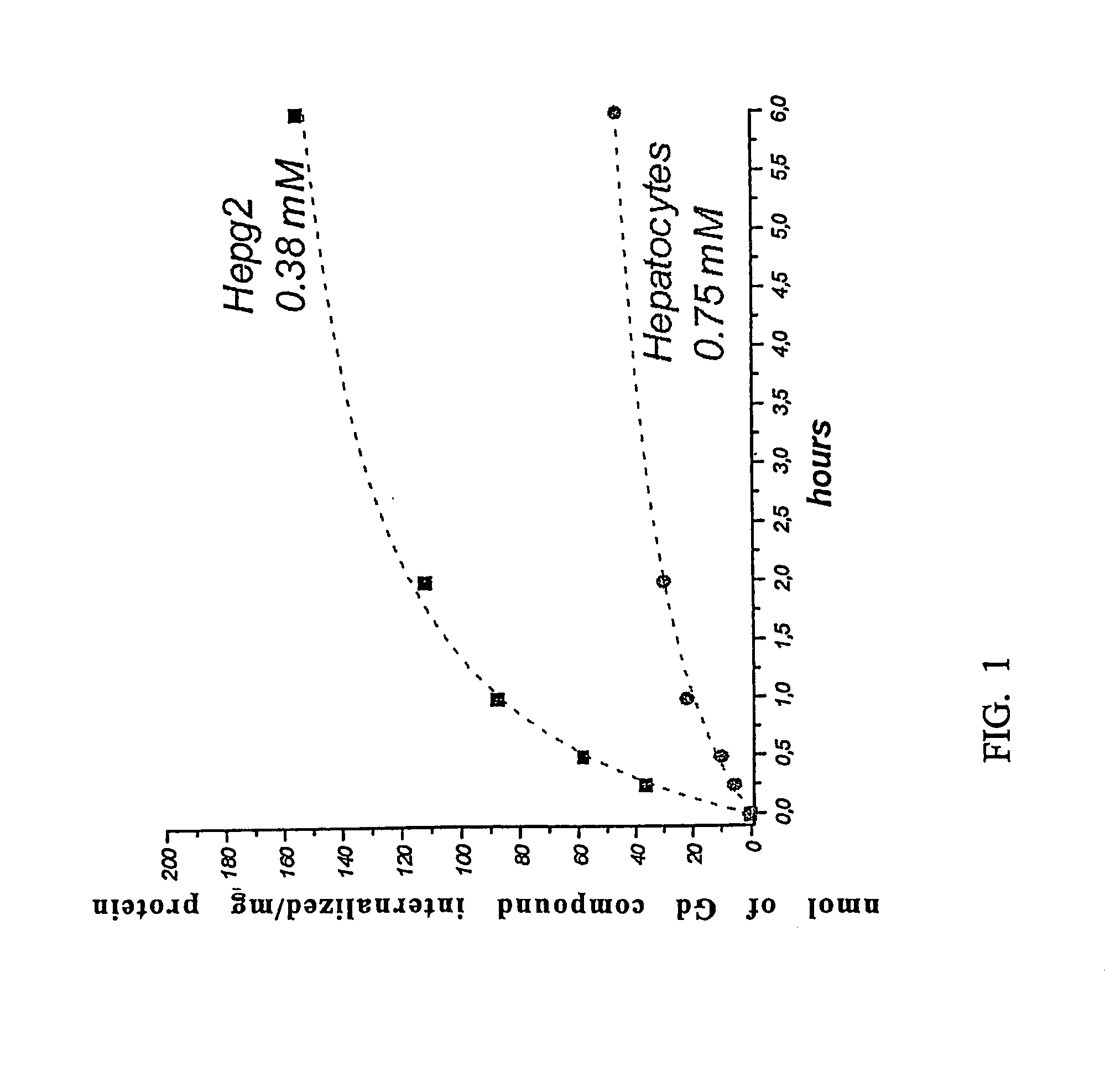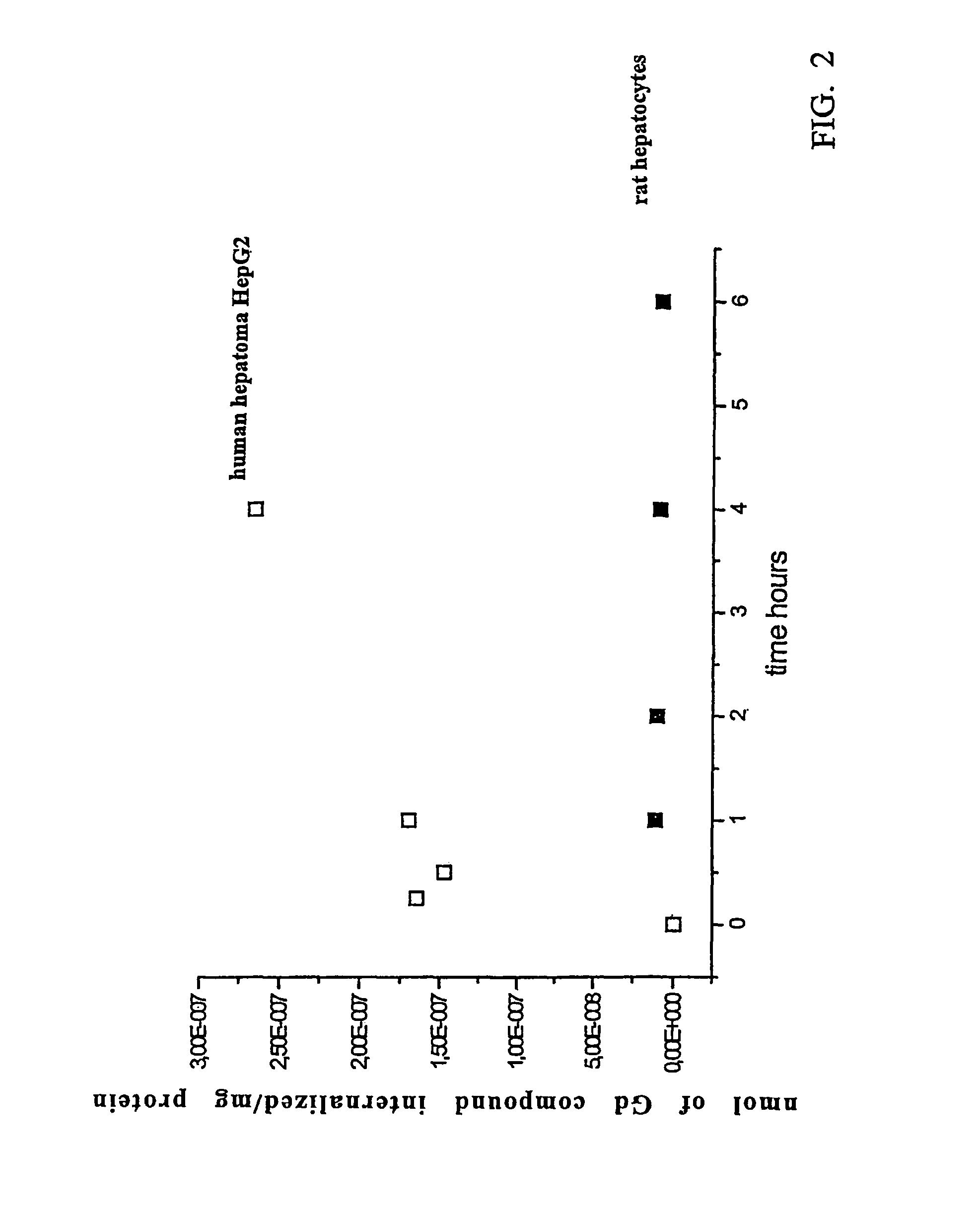Agents for magnetic imaging method
a magnetic imaging and agent technology, applied in the field of nuclear magnetic resonance technique, can solve the problems of difficult differentiation of the tissue of interest from the surrounding tissue in the resulting image, low efficiency of magnetic imaging, and high toxicity of metal ions, and achieve the effect of easy internalisation into the cell
- Summary
- Abstract
- Description
- Claims
- Application Information
AI Technical Summary
Benefits of technology
Problems solved by technology
Method used
Image
Examples
example 1
Preparation of the Gadolinium Complex of 6,16-dicarbonyl-5,8,11,14,17-pentaaza-8,11,14-tricarboxymethyl-heneicosandiguadinine
(Gadolinium Complex of N,N′-(4-guanidinobutyl)diethylenetriaminopentaacetic Acid bis-amide)
[0108]
a) Preparation of Diethylenetriaminopentaacetic Acid bis-anhydride
[0109]Diethylenetriaminopentaacetic acid (10 g; 0.0255 mol) and pyridine (14.54 ml; 0.18 mol) are charged into a 100-ml reaction flask equipped with magnetic stirrer, heating oil bath, and dripping funnel. While the temperature is kept at the room value and the solution is stirred, acetic anhydride (10.56 ml; 0.11 mol) is added dropwise. The reaction mixture is heated to 65° C. for 3 hours, and then cooled to room temperature. The solid obtained is recovered by filtration on büchner, washed on filter with acetic anhydride (2×10 ml), methylene chloride (2×10 ml) and ethyl ether (2×10 ml). The white powder is then dried under vacuum yielding 8.82 g of the compound of title a) (97%).
[0110]The 1H-NMR, 13...
example 2
Preparation of the Gadolinium Complex of 6,16-dicarbonyl-5,19-dicarboxy-5,8,11,14,17-pentaaza-8,11,14-tricarboxymethyl-heneicosandioic Acid Diamide
(Gadolinium Complex of N,N′-glutamin-diethylenetriaminopentaacetic Acid bis-amide)
[0114]
a) Preparation of 6,16-dicarbonyl-5,19-dicarboxy-5,8,11,14,17-pentaaza-8,11,14-tricarboxymethyl-heneicosandioic Acid Diamide
[0115]A solution of L-glutamine (5.00 g; 0.0342 mol) in water (80 ml) is loaded into a 100-ml reaction flask and sodium hydroxide (1.37 g; 0.0342 mol) is added thereto. While keeping the reaction temperature at 15-20° C., diethylenetriaminopentaacetic acid bis-anhydride obtained as described in step a) of Example 1 (6.11 g; 0.0171 mol) is added portionwise and the reaction mixture is stirred under nitrogen atmosphere for 4 hours. The pH of the reaction mixture is then neutralised by the addition of HCl and the solvent is evaporated off under reduced pressure yielding a white product that is purified by column chromatography on Amb...
example 3
Preparation of the Gadolinium Complex of 3,6,9-triaza-3,6,9-tricarboxymethylundecanoic Acid bis-glucopyranosylamide
[0118]
(gadolinium complex of N,N′-glucosamin-diethylenetriaminopentaacetic Acid bis-amide)
a) Preparation of 3,6,9-triaza-3,6,9-tricarboxymethylundecanoic Acid bis-glucopyranosylamide
[0119]A solution of glucosamine (1.00 g; 0.00463 mol) in DMSO (10 ml) is charged into a 100-ml reaction flask and kept under stirring at 40° C. A solution of diethylenetriaminopentaacetic acid bis-anhydride obtained as described in step a) of Example 1 (0.746 g; 0.00209 mol) in DMSO (5 ml) is slowly added thereto and the reaction mixture is stirred under nitrogen atmosphere for 4 hours. Methanolic KOH is added to bring the pH of the reaction mixture to 8 and the reaction product is then precipitated by addition of methanol followed by the addition of acetone. The precipitate is washed several times with fresh acetone to remove DMSO still present and the product is then dried under vacuum. Yi...
PUM
| Property | Measurement | Unit |
|---|---|---|
| atomic number | aaaaa | aaaaa |
| atomic number | aaaaa | aaaaa |
| atomic number | aaaaa | aaaaa |
Abstract
Description
Claims
Application Information
 Login to View More
Login to View More - R&D
- Intellectual Property
- Life Sciences
- Materials
- Tech Scout
- Unparalleled Data Quality
- Higher Quality Content
- 60% Fewer Hallucinations
Browse by: Latest US Patents, China's latest patents, Technical Efficacy Thesaurus, Application Domain, Technology Topic, Popular Technical Reports.
© 2025 PatSnap. All rights reserved.Legal|Privacy policy|Modern Slavery Act Transparency Statement|Sitemap|About US| Contact US: help@patsnap.com



